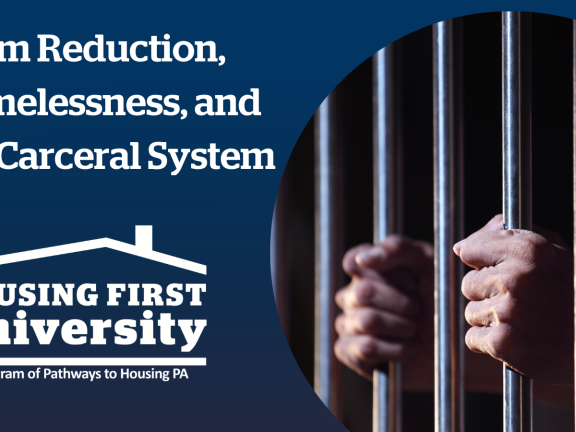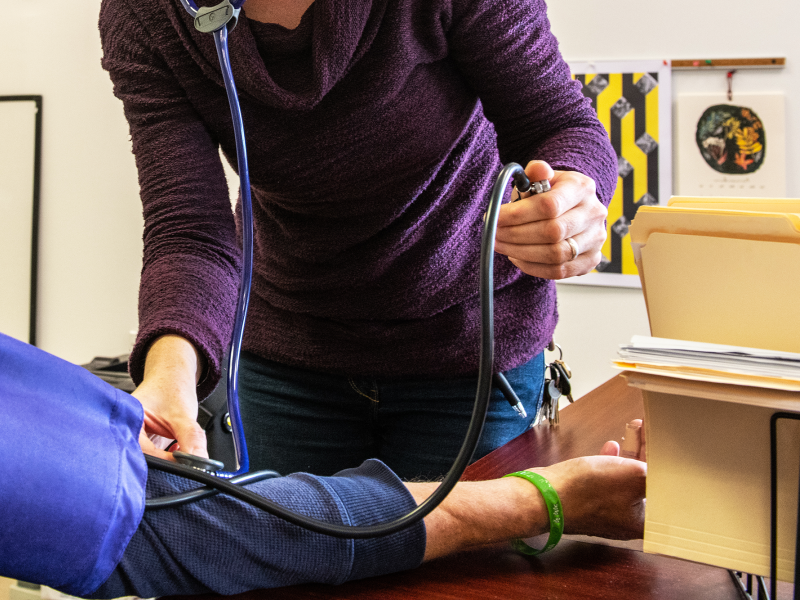Harm Reduction, Homelessness, and the Carceral System

According to the National Harm Reduction Coalition, “[h]arm reduction is a set of practical strategies and ideas aimed at reducing negative consequences associated with drug use. Harm Reduction is also a movement for social justice built on a belief in, and respect for, the rights of people who use drugs.” Harm reduction focuses on meeting the person where they are at, respecting the dignity and worth of every person, as well as their autonomy and right to self-determination. This includes individuals with substance use disorders in the carceral system, as well as those experiencing homelessness. In order to apply harm reduction principles in our work with these populations, we must first understand the relationship between substance use, homelessness, unemployment, and recidivism in the carceral system.
Between 2019 and 2022, there were over 373,500 people incarcerated for a drug related offense across the United States. This means that one out of every five incarcerated persons is there because of a drug-related offense, including possession of a controlled substance, intent to distribute or sell, drug paraphernalia, drug manufacturing, and drug trafficking. Each year, there are over a million people arrested for drug possession nationwide.
Within the United States, substance use disorders are seen as an individual problem rather than a public health crisis. The National Institute on Drug Abuse found that as of June 2020, about 65% of the U.S. prison population had an active substance use disorder, while another 20% were under the influence of a substance at the time of their arrest. Yet, a 2019 study reported that only 5% of people with opioid use disorder in jail or prison received medication-assisted treatment (MAT), a medication for opioid use disorder commonly used in harm reduction practice.
A 2018 report by the Prison Policy Institute found that “formerly incarcerated people are almost ten times more likely to be homeless than the general public.” When people are released from prison, they often have trouble finding and maintaining housing, which can lead to experiencing homelessness. This is because formerly incarcerated people are discriminated against on housing and employment applications due to their criminal history, and therefore have increased barriers to accessing permanent housing and stable employment.
The unemployment rate for formerly incarcerated people is nearly five times higher than the unemployment rate for the general population in the United States. Barriers to stable employment inevitably make it more difficult for someone to afford rent and other basic necessities such as food, clothing, or hygiene products. The Prison Policy Institute reports that while “203 out of every 10,000 formerly incarcerated people were homeless, nearly three times as many – 570 out of every 10,000 – were housing insecure,” which “provides a more realistic measurement of the number of formerly incarcerated people denied access to permanent housing.” Housing insecurity refers to people who are experiencing sheltered and unsheltered homelessness, “as well as those living in marginal housing like rooming houses, hotels, or motels.”
One way of applying harm reduction principles to these challenges could include banning the box on housing and employment applications, which refers to the removal of the criminal history question on applications that ask whether a person has been previously convicted of a crime. This would afford formerly incarcerated people an increased ability to support themselves financially and secure a place to live. Other strategies, like increasing the availability of affordable housing, could include galvanizing local governments around the issue of low-income housing development and incentivizing acceptance of section eight vouchers for landlords.
Preventing fatal overdose for people who use drugs exiting the carceral system is also a significant concern. To start, we should be working to increase access to medication-assisted treatment programs, including for individuals confined in carceral facilities. For those participating in MAT who then become incarcerated, we must find ways to seamlessly continue treatment protocols to prevent withdrawal and the increased likelihood of fatal overdose upon release. Additionally, access to and training on administration of naloxone is critical to reversing the effects of opioid overdose and saving lives. Dispensing naloxone to individuals as part of the release process could significantly reduce the risk of fatal overdose during transition back into the community.
Harm reduction practices are critical when working at the intersection of people experiencing homelessness and the carceral system, especially for those who also have substance use disorders.
Access to housing is a basic human right. Barriers to that right created by the carceral system and other policies further exacerbate the likelihood of individuals experiencing homelessness. By applying harm reduction principles and strategies across the disciplines of housing, social services, healthcare, and criminal justice, we can begin to decrease the cycle of people with substance use disorders experiencing homelessness following periods of incarceration and facing recidivism.
Amy Thissell (she/her) is a former social work intern. She received her Bachelor of Social Work from Simmons University in Boston, Massachusetts, and is currently attending the Graduate School of Social Policy & Practice at the University of Pennsylvania earning her Master of Social Work degree with a specialization in criminal justice. Amy has experience working at the Defender Association of Philadelphia in the Children and Youth Justice Social Services Unit and is passionate about criminal legal reform.


